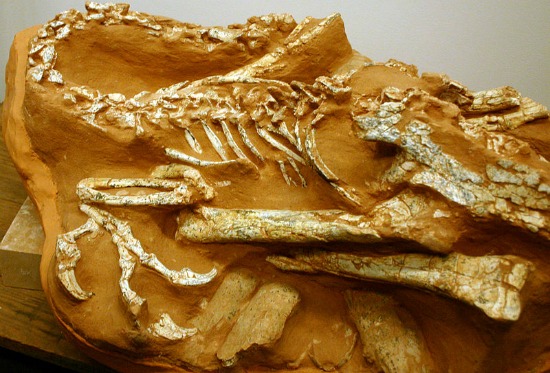Will We Ever Find Dinosaurs Caught in the Act?
Is there any chance that paleontologists will one day find mating dinosaurs?
Will we ever find mating dinosaurs? No one knows, but the discovery of fossils showing dinosaur behavior—such as this nesting oviraptorosaur—hint that we may someday find dinosaur sex set in stone. Photo by Steve Starer, image from Wikipedia.
Earlier this month, I wrote a short article for Nature News about 47-million-year-old turtles that died at a very inopportune moment. Several pairs of prehistoric turtle were fossilized in the act of mating—the tragic consequence of sinking to the toxic depths of a prehistoric lake. An unfortunate fate for the reptiles, but a boon for the paleontologists who found the sexy fossils.
The discovery got me thinking about dinosaur sex. I’ve written quite a bit about the topic before—I ran a four-part series on what we know about dinosaur nooky earlier this year—but much of what we know about dinosaur reproduction only outlines the mating habits of Apatosaurus and company. There’s still a lot we don’t know. In fact, some of the most basic questions are the most persistent. What, exactly, “dinosaur style” looked like has been a subject of frequent speculation but very little rigorous research, and no dinosaurs have ever been found fossilized in the act to show us how it was done. But does this mean that we’ll never find dinosaur sex preserved in stone?
Copulation is typically a brief moment in time. For such an intimate snapshot to become part of the fossil record, exceptional circumstances are required. In the case of 320-million-year-old sharks preserved in what may be part of a mating ritual, a quick death and rapid burial in fine-grained sediment locked the fishy forms in rock. We also know a little about how prehistoric insects reproduced thanks to mating pairs trapped in amber. And as for the turtles, the copulating reptiles drifted down to a layer of water that not only killed them, but kept their bodies safe from scavengers as sediment settled on their bodies. For sex to make it into the fossil record, a quick death, rapid burial and high-definition preservation are all required.
Given these conditions, I’m not very hopeful that paleontologists are going to find mating dinosaurs. Even the smallest dinosaurs were too big to be trapped in amber, and as fully-terrestrial animals, dinosaurs did not copulate in the sort of aquatic environment where fast death and burial would have been possible. Dinosaurs just didn’t mate in the kind of habitats where there was a high potential for the amorous pairs to perish and be entombed in sediment. Good news for them, but frustrating for paleontologists.
Still, I shouldn’t be too hasty in saying that we’ll never find mating dinosaurs. I never expected that paleontologists would discover turtles caught in the act, for one thing. And the fossil record is full of surprises, including fossils that detail some aspects of dinosaur behavior. Paleontologists have previously discovered dinosaurs preserved in nesting and sleeping positions, and there’s the fighting dinosaur pair. Maybe someday a fortunate paleontologist will help us solve the prehistoric mating mystery by finding dinosaurs that made love, not war.
/https://tf-cmsv2-smithsonianmag-media.s3.amazonaws.com/accounts/headshot/RileyBlack.png)

/https://tf-cmsv2-smithsonianmag-media.s3.amazonaws.com/accounts/headshot/RileyBlack.png)